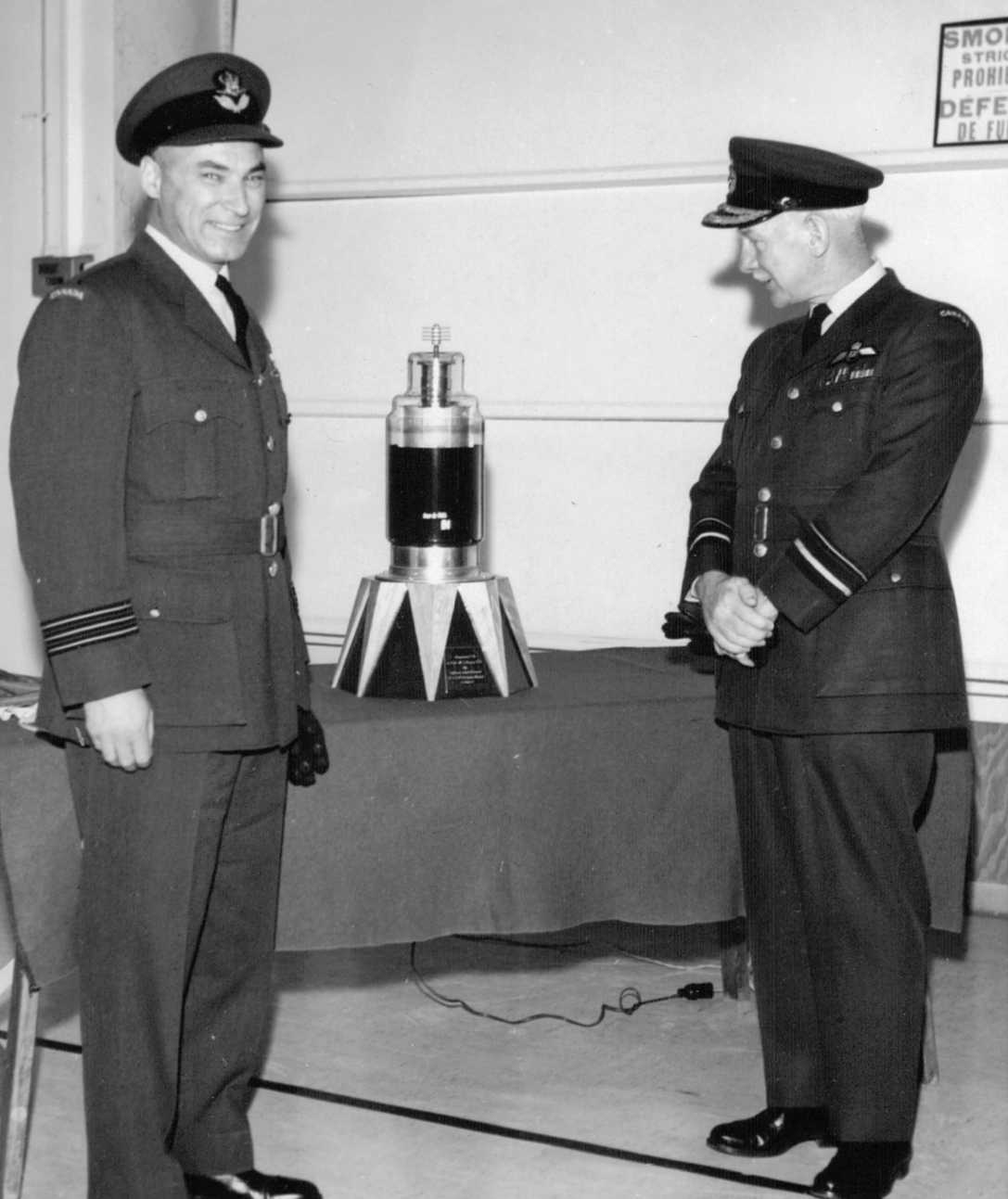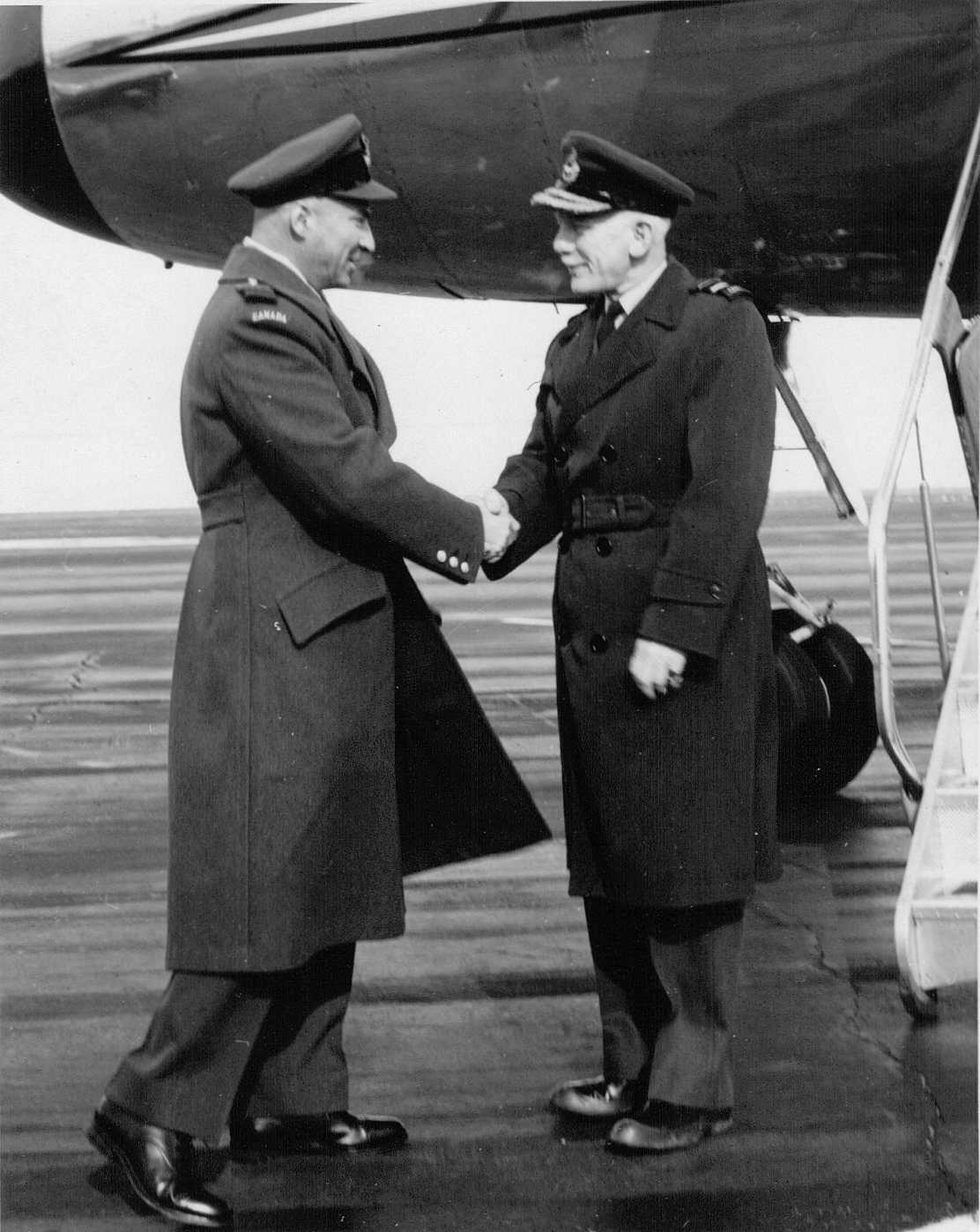 |
The Life and Times of Hubert Brooks M.C. C.D.
A Canadian Hero
|
 |
Chapter 15: August 1965 to July 1967 : R.C.A.F. Radar Station Moisie, Quebec
15.3 R.C.A.F. RADAR BASE MOISIE

|
Postcard Showing Call Sign for Amateur Radio Club at RCAF Moisie.
Postcard was mailed to Contacted Party

|
|
Operationally we had three radars, with the major units being the FPS–26 (Canadian General Electric Height Finding Radar) and FPS–27 that served us
well.
The radars were supported by a remote facility located about half a mile down the road called the Ground Air
Transmit Receive (GATR) facility (constructed by Northern Electric Company) with the Burroughs Corporation AN/FPS–2 SAGE computer.
We were part of the NORAD Surveillance system feeding into Bangor, Maine.
The base was responsible for maintenance of both the radar and GATR computer facility. There were many problems on
the mechanical side including: frozen heat exchanges, and antenna rotation and calibration difficulties on all three radars.
Like most remotely located R.C.A.F. Stations the base was essentially a self contained entity.
On base there were:
- Housing for married couples ... there are 86 Married Quarters on the unit to be allocated to newcomers when availability
permits. The MQs consist of 8 four bedroom units, 59 three bedroom units and 19 two bedroom units.
- Barracks for single airmen ....five single quarters are provided for single and unaccompanied personnel - these people are
housed in double storied Barrack buildings 1 or 2 men to a room depending on rooms available.
- Both Protestant and Catholic Schools covering grades 1 to 6 (we bused our kids into Sept Iles for grades beyond
grade 6 .... Queen Elizabeth High School for the English or Our Lady for the French)
- Hockey Rink
- Baseball diamond/ football / soccer field which was transformed into a steep toboggan hill for the kids in winter
- Tennis Courts
- Gas Station
- Both Protestant and Catholic Churches
- Station Credit Union
- Ham Radio Shack ( see call sign on Postcard in image at right)
- Recreational Complex including:
- Gym
- Swimming pool... 60 foot by 20 foot in dimensions
- Movie theatre .. with an 80 seat theatre
- Bowling Alley ... two lanes....
- Restaurant
- Post Office
- Teen Town (formal home of base radio station CFRM)
- Besides the basketball, volleyball, badminton and judo clubs and teams that made their home in the recreation center,
there were Officer & Sergeant vs airmen hockey matches and softball matches, there was an active curling team, and a fish and game club.
Competitive snow show races in the winter were always a favorite.


|
The Station has an active Fish & Game Club equipped with four motor boats. The Moisie River is known to be one of the best Atlantic Salmon fishing grounds on the North
American continent. Brook and sea trout may also be caught in these waters. The St. Lawrence River abounds in cod, halibut and mackerel. Clams can be dug up on the sand flats at the mouth of
the Moisie River. During the month of May, a small smelt like fish, the caplan, literally rolls with the waves onto the beaches. The eager trout fisherman can take his tent and sleeping bag on the
Quebec North Shore and Labrador Railway to find almost virgin spots.
The children loved the self contained environment which focused friendships and with the range of facilities they
certainly had enough to do.
Many families also very much enjoyed the environment and several officers and air men campaigned to be re–posted
to the base. The summers at Moisie were pleasant, with the temperature often rising above 70 degrees F almost always accompanied by a light breeze. Winters brought heavy snow falls enjoyed by all
since the temperatures seldom fell below 0 degrees.
In Moisie on the north shore of the St Lawrence River, the winters were long with lots of snow and the summers could
be reasonably warm (mid to high 60s) with lots of black flies. We needed to constantly spray around the station to keep base personnel from being
eaten alive – the problem was severe if you went off base – as a lot of blueberry pickers quickly found out.
As CO I and my officer team had both the expected day–to–day issues to deal with and also the
unexpected issues from time to time:
- problems with radar equipment malfunction and associated down time,
- ensuring proper equipment maintenance,
- HR issues,
- reporting to command,
- asking HQ what they were thinking when in 1966 we received a ‘new’ telephone exchange and switchboard in 1966, new, from the Quebec
Telephone Company
– it was at least 15 years old, and functioned like it was 20 years old
- I had campaigned for a combined Corporals and Aircraftmen's Club. On 31 December 1966 saw the official opening and the event was celebrated by a
New Year's Eve party of exceptional length and conviviality!!
- court martial of an airman stealing from the base's gas bar
- ......to list just a few
In addition, the base looked after fire protection in the town of Moisie and provided them with emergency water
supply from time to time when conditions warranted.
LEFT: Guard Hut at Entrance to Radar Site at RCAF Moisie
CENTER: Entrance to Radar Site at RCAF Moisie
RIGHT: Aerial View of RCAF Moisie
|
|
|
LEFT: Main Station Road to Radar Domes
CENTER: View from Moisie River Beach of Radar Domes and Enlisted Men Quarters
RIGHT: Close Up View of Radar Domes
|
|
|
LEFT: Aerial View of R.C.A.F. Moisie Radar Domes From End of Peninsula.
Moisie River to the right
CENTER: Base Level View of Radar Domes
RIGHT: View of Radar Domes From Moisie River Beach in Winter
(only snow covered beach can be seen in photo) St Lawrence River
can be seen at top of Picture.
|
|
|
Aerial Views of R.C.A.F. Moisie Station.
LEFT PHOTO: Radar Domes and Supporting Operational Buildings with Moisie River in Top of PHOTO
RIGHT PHOTO: Married Quarters are seen in the Middle Left of Photo,
Base Operations Middle Center of PHOTO
and Radar Domes Middle Right of PHOTO.
|
|
|
|
Entrance to RCAF Moisie Church - served both Catholics and Protestants

|
|
LEFT: Guard Hut at Entrance to Radar Site at RCAF Moisie In Winter
CENTER: Support Buildings at RCAF Moisie In Winter
RIGHT: Married Quarters Street at RCAF Moisie In Winter
|
|
|
Aerial View of R.C.A.F. Moisie Station.
LEFT PHOTO: Top - left to right- Highway to Sept Iles
Middle Right: Officer and NCO Married Quarters
Middle Center: Baseball Diamond Bookended by Catholic and Protestant Grade Schools ... Hockey Rink on Right by Forest
Middle Left: Enlisted Men Married Quarters
Bottom Left: Enlisted Men Barracks
RIGHT PHOTO Moisie River can be seen TOP LEFT in photo where Radar Domes are also visible;
(Wind Break) Forest Woods can be seen in darkened bottom
and left of photo
Base Married Quarters are seen "above" bottom woods
|
|
|
TOP ROW:RCAF Station Moisie Recreation Center Buiding Entrance
BOTTOM ROW: Some Facilities Within RCAF Moisie Recreation Centre
LEFT PHOTO: Movie Theatre
CENTER PHOTO: Snack Bar
RIGHT PHOTO: Indoor Swimming Pool
|
|
|
LEFT: RCAF Moisie Fire Hall
CENTER: Recreation Equipment outside School at RCAF Moisie
RIGHT: Airmen Play Softball at RCAF Moisie Baseball Diamond on Sadie Hakins Day
|
|
|
LEFT: Photo of Outside of Airmen's Mess in winter
CENTER:Photo of Beach on Moisie River next to RCAF Moisie ....
Often very windy!
RIGHT:Photo of RCAF Moisie Radar Domes
Beach Photo Courtesy: Don Campbell
RIGHT Photo Courtesy:John Sobey
|
|
1966 PINETREE LINE Commanding Officers ‘TEAM’ PHOTO – W/C Hubert Brooks
2nd row from front 3rd from right
Photo Courtesy: Hubert Brooks Private Collection
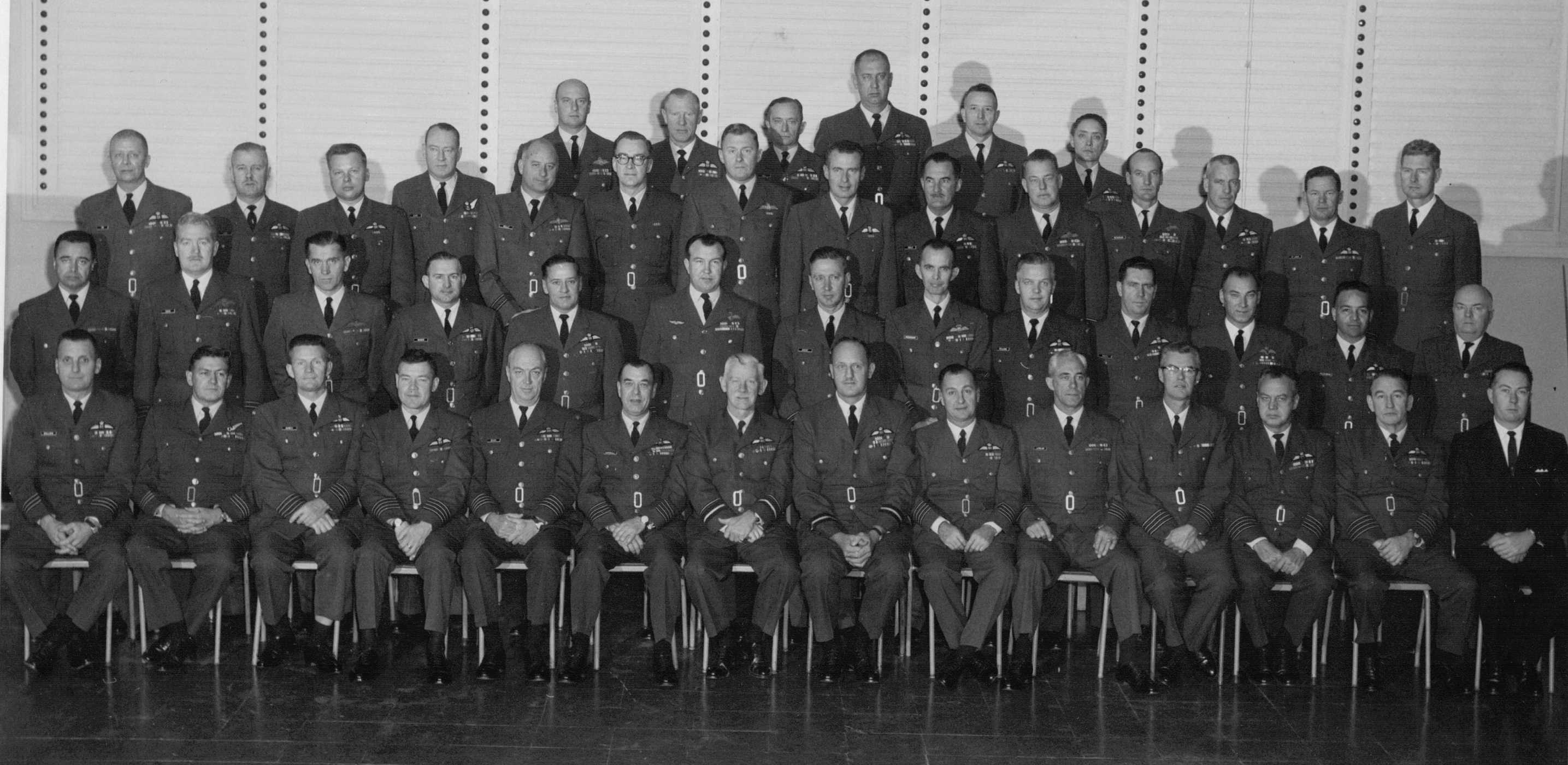
|

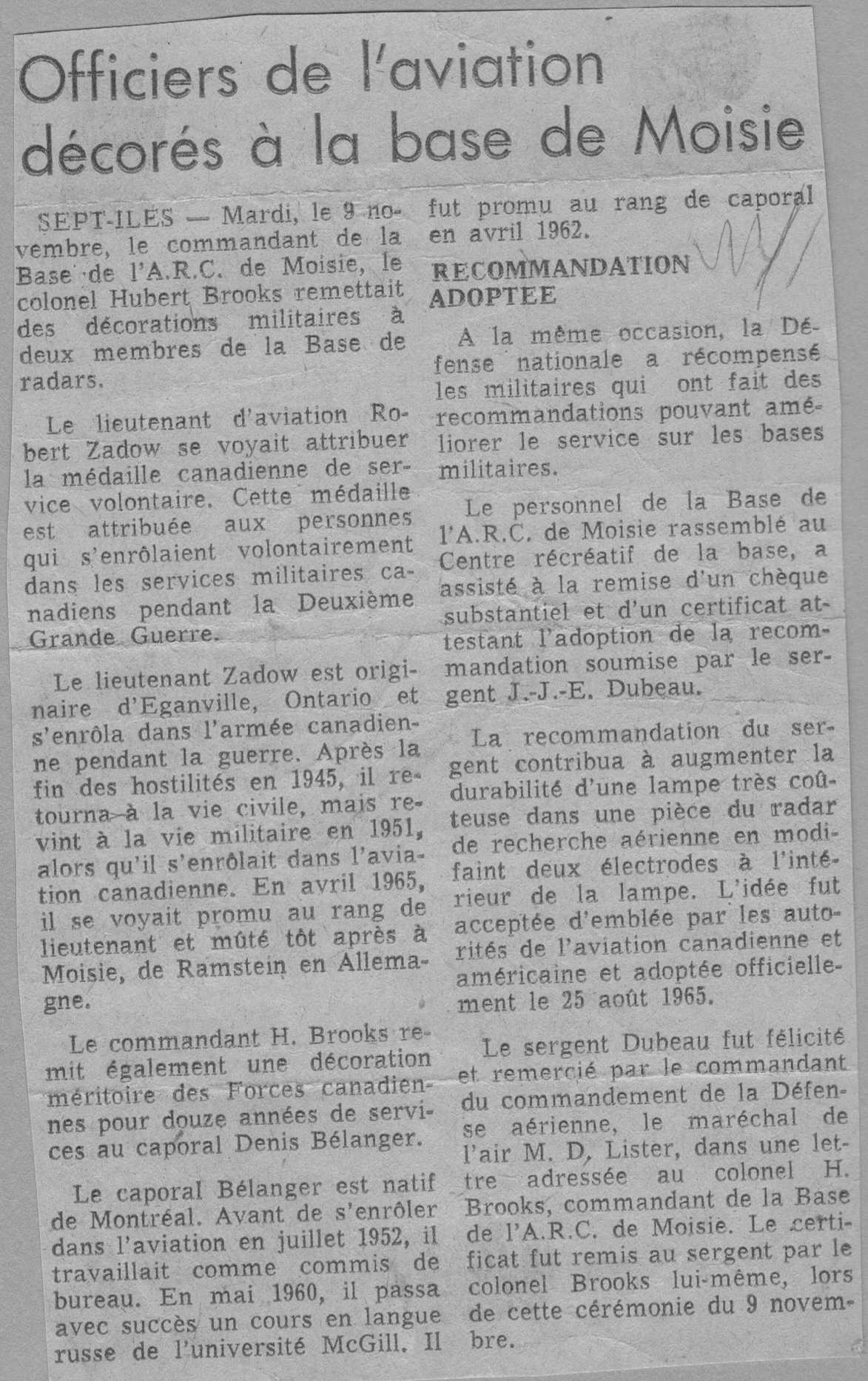
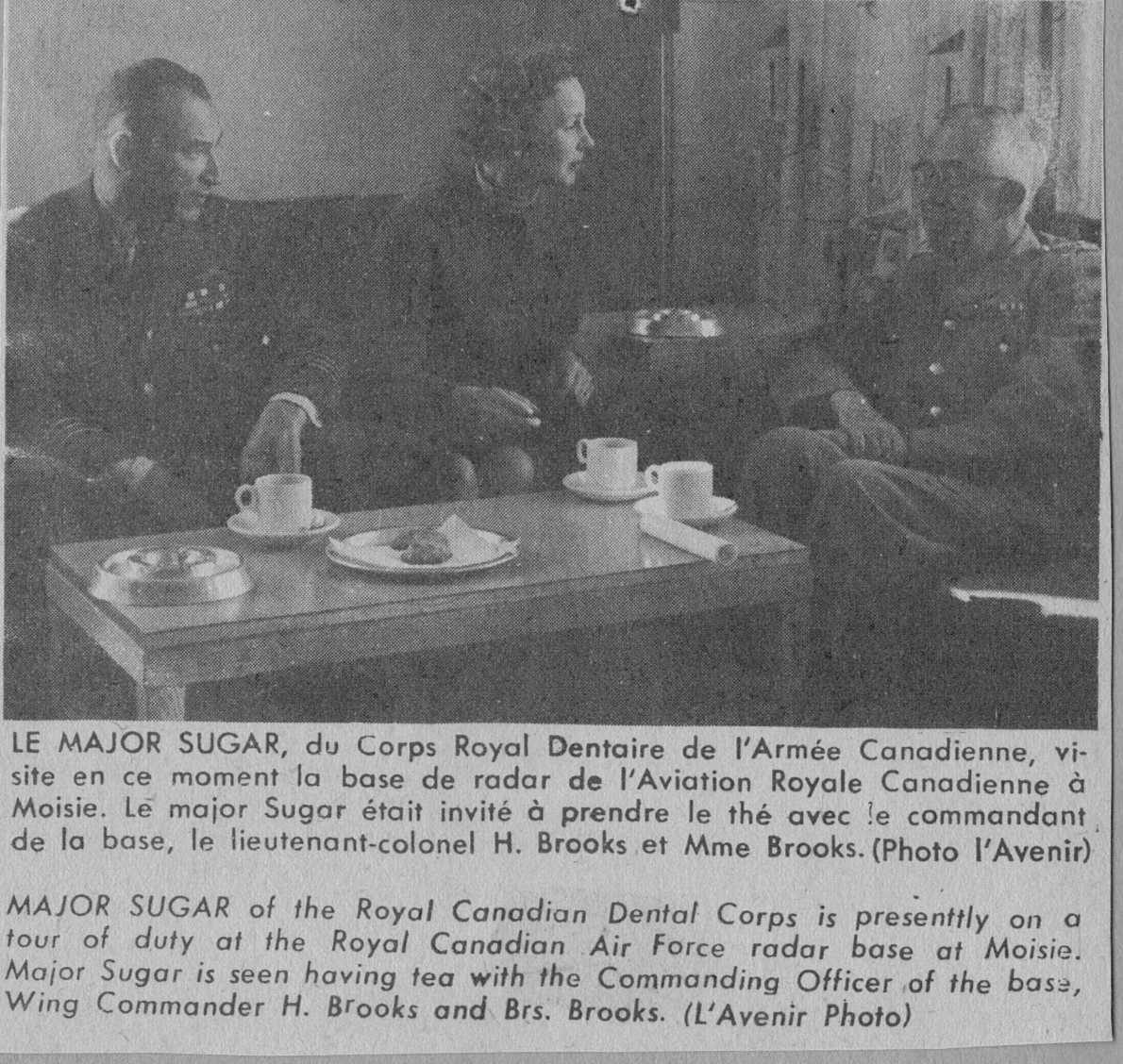
PROMOTION TO WING COMMANDER:
On 14–January–1966 the R.C.A.F. promoted me to Wing Commander (the acting prefix was no longer in my HR file)
with seniority back dated to 5–Aug–1965 (when I had been first assigned to Moisie).
1967 brought with it two changes to the Station's name; first from R.C.A.F. Station Moisie to 211 Radar Squadron Moisie and then, just after
I'd left, on the 10 August 1967 it assumed the name it held till base closure, Canadian Forces Station Moisie.
Flying Hours
While at Moisie I tried best I could to maintain my flying hours. I would make it down to R.C.A.F. St. Hubert
and for a 5 day or so stretch fly around the country. Again I was navigator in C–45 and C–47 aircraft.
For the 10 year period leading up to the end of 1966, for each of the major aircraft types I'd flown sub–totals
were as follows:
- Lancaster: 210 hours
- C–45: 84 hours
- C–47: 308 hours
- P2V–7: 489 hours
Total flying hours as navigator for all aircraft since I joined up now stood at 2,450 hours.
The Life and Times of Hubert Brooks M.C. C.D.
Copyright © 2011, 2012, 2013, 2014, 2015, 2016, 2017, 2018, 2019, 2020, 2021, 2022, 2023, 2024 Ralf Brooks, All Rights Reserved










